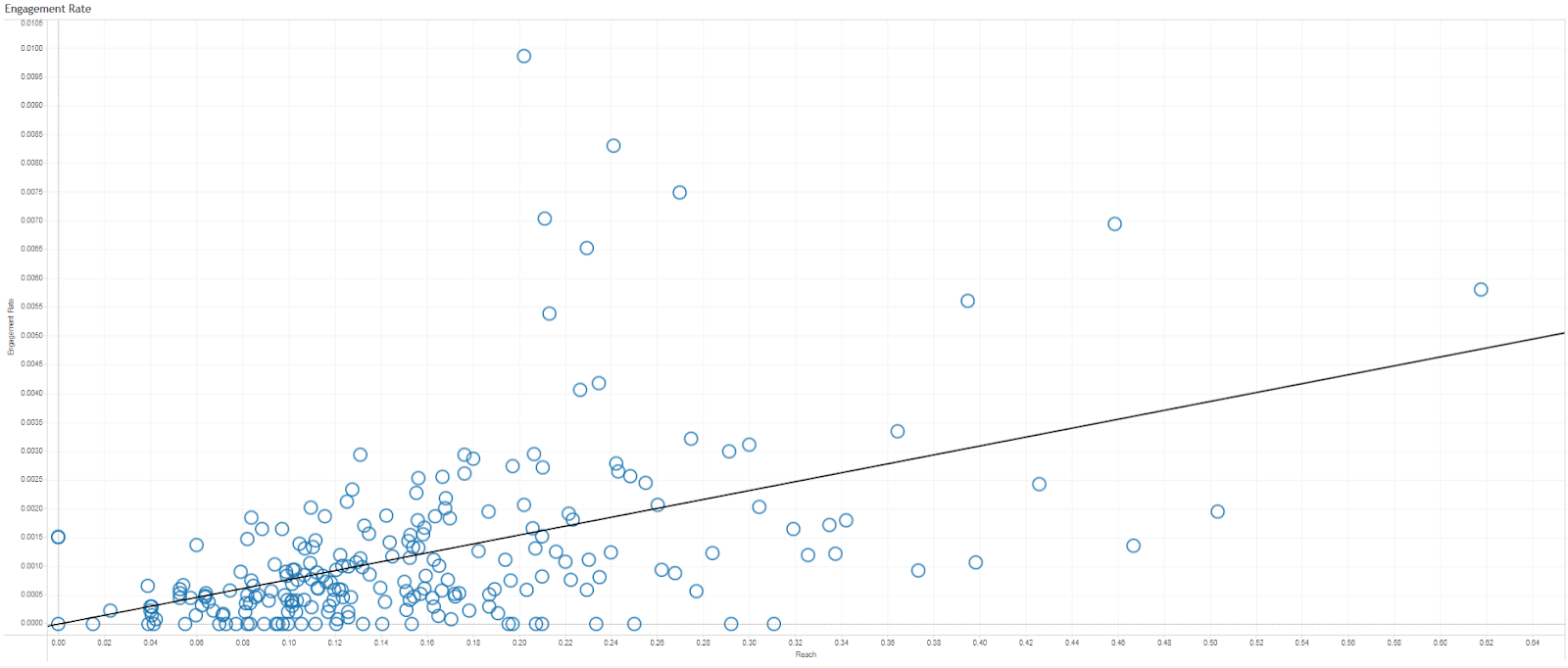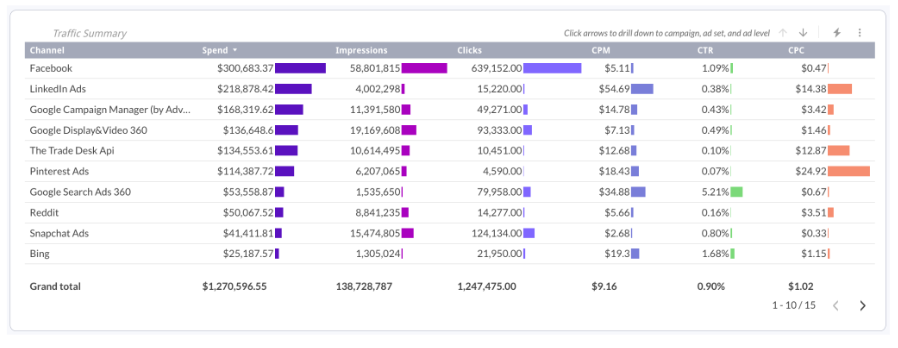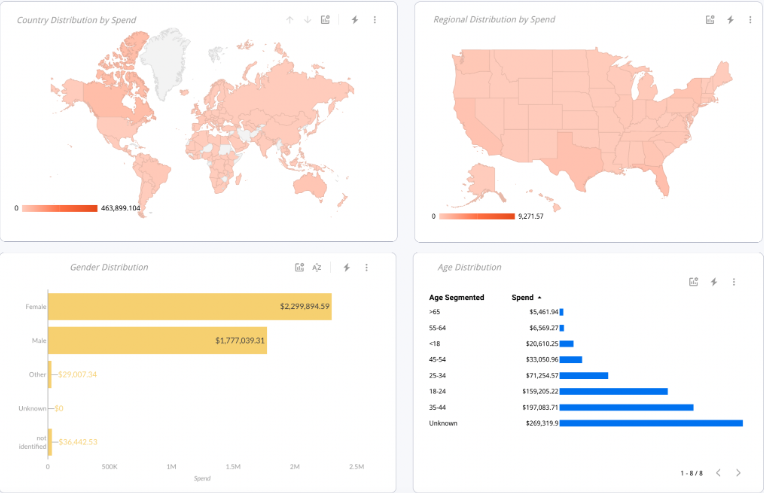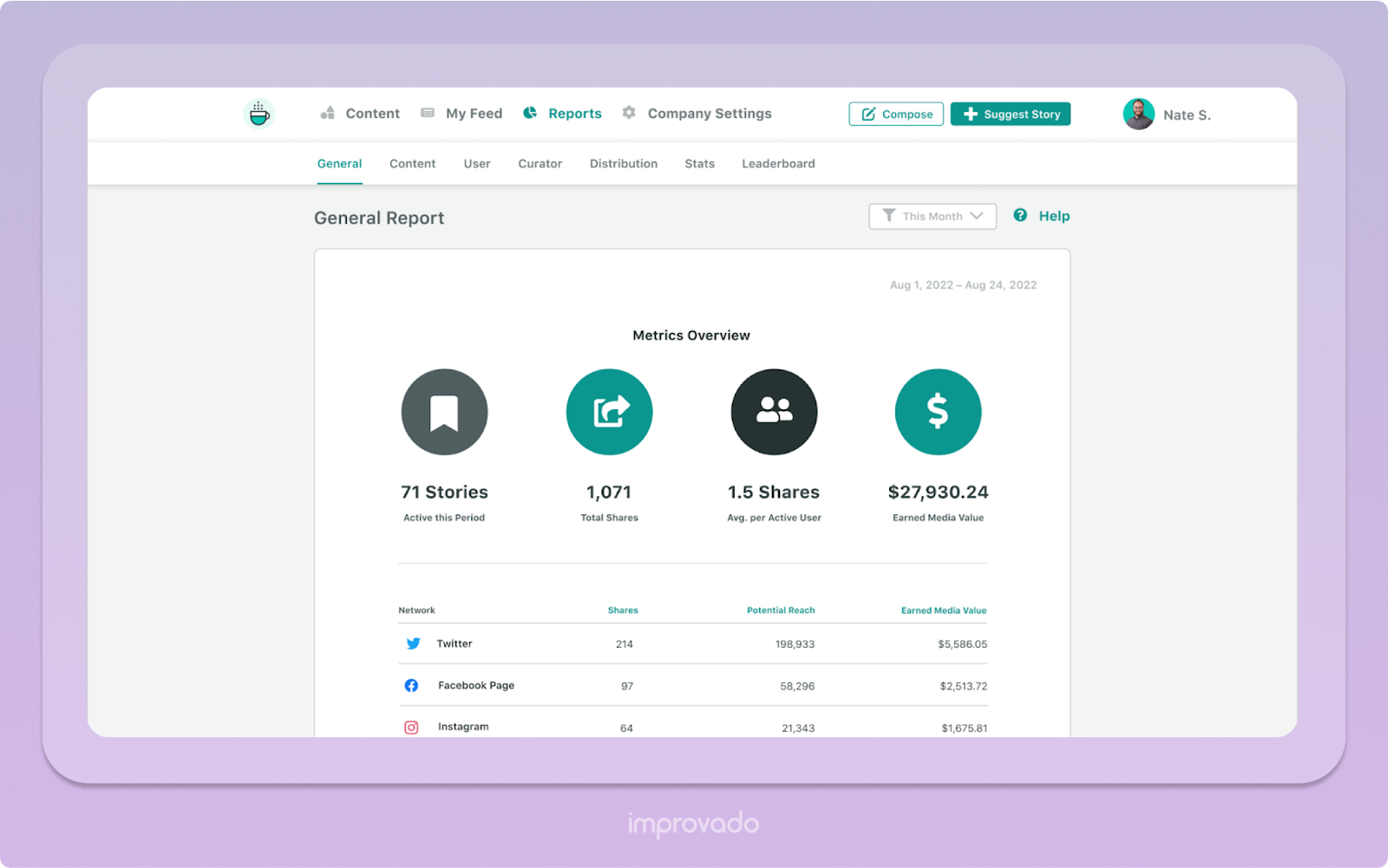Social media analytics goes way beyond reach, clicks, and engagement rate. Imagine a quarterly report presented to the C-Suite saying that your team doubled the impressions and gained a 20% growth in followers.
While these numbers are valuable for the social media team, CFOs and CEOs operate with completely different metrics. They want to see how social media contributes to the revenue growth and what’s the ROI of your efforts.
A holistic media dashboard is an effective way to get granular insights for your day-to-day tasks, as well as to provide an overview of all KPIs to stakeholders. A visualized story of your activities during the quarter better explains how those posts, clicks, and engagement impact revenue generation.
Here, we’re exploring what a social media dashboard is, why it’s crucial for businesses today, and the best practices to know when using third-party solutions. We will also look at real-world examples to help you understand the power of an effective social media analytics dashboard.
What Is a Social Media Dashboard?
A social media dashboard is a type of online marketing dashboard that helps you maximize ROI of your social media campaigns by providing an overview of key metrics and explaining how they drive your company to its goals.
Having access to this data allows you to optimize campaigns and:
- Get a higher return on ad spend (ROAS),
- Drive conversions,
- Measure the success of your efforts.
Benefits include:
- At-a-glance overview of metrics,
- Tracking performance capability across all channels,
- Ability to optimize campaigns,
- Gaining insights into customer behavior,
- Measuring success easily,
- Automating processes.
Social media dashboards enable you to monitor campaigns on-the-go, reevaluate your marketing strategy, optimize social media ads, and make informed decisions generally.
What should be in a social media dashboard?
Different metrics serve different goals. While impressions might indicate the growth of brand awareness, direct social purchases on social media influence bottom-funnel conversions. The charts and visualization styles might differ from dashboard to dashboard, but there’s a set of essential metrics that always need to be present on your social media dashboard.
Let’s go through all the vital metrics that should be present on your dashboard. But first, take a look at a LinkedIn overview dashboard from Improvado showcasing all vital metrics you need to keep an eye on.
Reach
Reach refers to the total number of unique accounts that have seen your ads. Reach is most often used to get a better understanding of your brand awareness.
Reach is considered to be a vanity metric that doesn’t show the real impact of your social efforts on the company’s bottom line. However, it’s still important to know how many users have seen your ads, if your business is scaling and aiming for new audiences. Without emphasizing on reach, many of your potential customers would have never heard of your brand, offer, or strong message.
Here’s an example of a social media engagement and reach dashboard showing you how many impressions, clicks, shares, and other metrics were generated by each of your social media posts.
Engagement rate
Engagement rate is another essential metric for a social media dashboard. It measures the amount of interaction a piece of content gets compared to reach or account’s followers count.
Here’s a formula to calculate the engagement rate for your social media marketing dashboard:
Total Engagement is the sum of all interactions you consider to be an engagement (likes, share, comments, etc.)
Total followers is the number of users who follow your social media account. Total followers is often changed to total reach, which is the total number of impressions generated by a particular post.
If you’re feeling a bit lazy to calculate it yourself, Hootsuite offers a free social media engagement rate calculator.
When it comes to displaying engagement rate on a social media dashboard, the visualization can be as simple as a regular line chart.
Alternatively, you can get more creative and come up with a scatter plot like this. It shows the correlation between each post’s engagement rate and reach.
Follower growth rate
Follower growth rate measures the speed at which your social media account is growing its audience. It is an invaluable indicator of your campaigns’ health. Plus, it helps you understand how do you keep up against your competitors and assess the projected share of voice for your brand on social media.
Use this formula to calculate your follower growth rate:
Social media monitoring dashboards usually have follower growth rates depicted in a form of a line chart. With a chart like this it’s easy to spot peaks and troughs within a given timeline.
Engagement metrics per post
This category includes all most common social media metrics such as likes, shares, replies, comments, etc. These metrics are a barometer of how your posts resonate with your audience. An engagement overview social dashboard is a go-to tool for marketers when analyzing their previous campaigns, optimizing them, and planning on new ones.
C-level metrics
Frankly, most executives don’t dive deep into reach or follower growth rates. They often don’t have time to figure out how these metrics influence actual company performance. That’s why you need a dashboard that speaks the same language as executives do. The language of revenue.
Executive dashboards are often tailored to each executive, so they can draw up quick conclusions in their areas of expertise. Some of the metrics are share of voice, earned media value, cost per acquisition, competitor analysis data, and more.
Why Build a Social Media Dashboard?
There are multiple reasons you want to use a social media dashboard. Most notably, a dashboard offers transparency, insights to optimize strategy, real-time data, and automated reporting, making analysis simple, quick, and effective.
Ensure quick access to performance insights
Social media dashboards offer the visibility needed to track performance across all social media campaigns. With an effective dashboard, you can monitor campaigns in real time, identify trends quickly, and make informed decisions that help you optimize your strategies and course correct when needed. In addition, this level of insight helps you stay ahead of the competition by ensuring you take advantage of every opportunity available.
Real-time streamlined data collection
Dashboards also streamline data collection from multiple sources into one central location. By aggregating data from all of your social channels, you gain valuable insight about customer behavior without having to manually search through each platform individually. In turn, you can better understand how customers interact with your brand online and tailor your marketing plan accordingly.
Automated reporting & analysis
Finally, the best social media dashboard will offer automated reporting and analysis capabilities, enabling you to save time when analyzing large amounts of data.
For example, some dashboards have built-in analytics tools so that you can generate reports based on specific metrics like engagement rate or click-through rate (CTR) over a certain period of time. This means you can measure success more accurately than ever before. Additionally, many dashboards are equipped with AI algorithms that detect patterns in user behavior so you can spot potential opportunities fast and act even faster.
Best Practices for Successful Social Media Dashboard Design
Social media dashboard tools are essential in today’s online marketing efforts. To get the most out of your dashboard, there are certain best practices to keep in mind.
Centralize data from all social media channels
To get a comprehensive social media dashboard you have to gather the required data first. That’s a complex process which requires your marketing team to:
- Define the list of social media platforms
- Set up API connections for every platform
- Set up a data storage capable of processing large amounts of data
- Load data into a centralized storage for further transformations
This is where marketing teams often face challenges. Since this step requires programming and database management know-how, non-technical marketers often can’t handle the task by themselves. As a result, they either stop building the dashboard or try to gather data manually, which becomes outdated by the time they finish gathering it.
Ensure high data granularity
It is essential to have the ability to get as granular as possible when creating a social media dashboard. Gaining deeper insights into the performance of each channel is the number one goal, so the more data you can access the more effective your dashboard will be.
Granular performance metrics across all platforms allow you to better tailor content and campaigns to maximize social media marketing impact.
Some social media dashboards allow you to dig deeper into different granularity levels. For example, Improvado’s paid social ads dashboard aggregates data from all social platforms and provides insights into channel, campaign, ad set, and each individual ad performance. With this level of insights, you can analyze your paid ads performance aggregatively or go deeper into performance of creatives and messaging.
Feed your dashboards with harmonized data
For your dashboard to be effective, it needs accurate data from all sources in a consistent format that’s easy to understand.
The major problem for today is that different platforms use different data formats and naming conventions. This means you can’t simply stitch data from different APIs into a single storage or spreadsheet without additional data manipulations.
These manipulations include:
- Data deduplication
- Cross-channel data mapping
- Alignment of naming conventions
- Joining and unioning data tables with SQL
Yet again, non-technical marketers can’t execute these processes properly and often push faulty data right to the dashboard. It results in blind spots in marketing analytics and leads to poor decisions.
Use automated alerts & reports
Automated alerts & reports provide real-time updates on key metrics such as:
- Impressions
- Clicks
- Conversions
- Etc.
Armed with this information, it is easier to stay ahead of any changes in campaign performance without having to constantly monitor each platform manually every day.
Be sure to set thresholds within the system, so you can receive notifications when certain metrics exceed or fall below identified levels. You want to have ample time to react so that you can be as proactive as possible before any potential issues arise that might result in lost revenue opportunities or worse.
Social Media Dashboard Examples
Improvado’s organic social dashboard
Improvado is an advanced marketing analytics platform empowering marketers to ask more questions and get more answers out of their data. The platform pulls data from all social media platforms to normalize them and stremline them to a holistic cross-channel dashboard.
The organic social dashboard provides you with insights into posts, clicks, reach, and engagement behind your social efforts.
Further, it provides more insights into your audience. You can break down your awareness, conversion, and engagement metrics by geo and demographics.
The engagement rate chart allows you to discover engagement anomalities on a given timeline and figure the viral loops they triggered.
A post performance summary is a useful tool to explore the power behind each post. This tab shows you the metrics generated by each post, allowing you to understand which posts better resonate with your audience.
Improvado’s paid ads dashboard
Improvado has another dashboard for marketers who launch paid ads campaigns on social media. The paid ads dashboard is an easy way to jumpstart your cross-channel analytics.
The dashboard allows you to spot CPC/CPM anomalies to quickly react on changes in campaign performance. What’s more, you can analyze correlations between the cost and quality of paid traffic.
With an ability to dig down into different dimensions, you can analyze channels, campaigns, ad groups, and creatives that drive awareness or generate conversions.
Another feature of a paid ads dashboard is that you can track your ad spend across multiple regions and geographies to target the most promising audiences.
Hootsuite dashboard
Hootsuite is a popular social media dashboard that provides users with an overview of their performance across multiple channels. It allows you to track key metrics such as engagement, reach, and impressions for each post or campaign. You can also set up custom reports to monitor progress over time. In addition, the dashboard includes several widgets that make it easy to view data in different ways and quickly spot trends or changes in performance.
Sprout social dashboard
Sprout Social’s dashboard offers detailed insights into social media campaigns. For example, it shows how well each post performs compared to others, so you know what content resonates best with your audience. In addition, you can track follower growth and see how many people engage with your posts on each platform. The dashboard also displays data about customer sentiment so you can quickly identify any potential issues before they become more significant problems.
Buffer analytics dashboard
Buffer’s social analytics dashboard helps you measure the success of campaigns across all major platforms, including Facebook, Twitter, Instagram, TikTok, LinkedIn, and more. It provides detailed insights into engagement rates for individual posts and overall account performance over time so you can adjust strategy if needed. Buffer’s reporting feature makes it easy to create customized reports showing what’s working or not on your social media platforms; this means you can focus future efforts on strategies that work for maximum impact.
Social media dashboards effectively visualize and analyze data from various sources, enabling you to understand your audience better and optimize your campaigns.
When you understand the best practices for a successful social media dashboard design, you can create an effective and efficient way to track data, analyze trends, and maximize lead generation strategies.
Monitor Your Marketing Performance Across Different Channels with Improvado
A well-designed social media dashboard helps uncover actionable insights into your social efforts to enable your future strategy. However, it’s a challenge to build one without a talented team of analysts or the automation tool.
Improvado is an advanced marketing analytics platform that aggregates data across any marketing platform and streamlines it to digestible dashboards, so you don’t have to do it. You can dive straight into analysis and decision-making instead of spending hundreds of hours on data extraction, transformation, and dashboard setup. With Improvado’s social media dashboards you can:
- Stay on top of the latest changes in your cross-channel marketing performance
- Customize the dashboard as you want. Start with general overview of all channels and dig down into performance of each social post or creative.
- Get vital marketing reports in a few clicks, instead of weeks
- Get insights that are equally for both marketing managers and non-marketing executives.
- Save time
Check out all the social media platforms, metrics, reports, and more that Improvado offers in our Data Dictionary.
500+ data sources under one roof to drive business growth. 👇
.png)
 (1).png)
.png)

.png)





















 (1).png)

.png)





.png)


.png)
.png)
